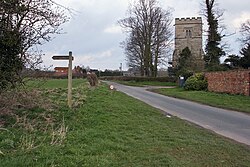Nunburnholme
| Nunburnholme | |
| Yorkshire East Riding | |
|---|---|
 The road into Nunburnholme | |
| Location | |
| Grid reference: | SE849480 |
| Location: | 53°55’19"N, 0°42’28"W |
| Data | |
| Population: | 234 (2011) |
| Post town: | York |
| Postcode: | YO42 |
| Dialling code: | 01759 |
| Local Government | |
| Council: | East Riding of Yorkshire |
| Parliamentary constituency: |
East Yorkshire |
Nunburnholme is a village in the East Riding of Yorkshire, three miles east of its nearest market town, Pocklington. The wider civil parish, including the hamlet of Kilnwick Percy, had a recorded population of 234 at the 2011 census,
The name ‘Nunburnholme’ derives its name from the Old English Burna holm, which means ‘brook island,[1] It appears variously as Brunnum, Brunham and Brunne in the Middle Ages. The prefix "Nun-" was added at some time before the 16th century with reference to Nunburnholme Priory.[2]
History
Nunburnholme was laid waste during the Harrying of the North in 1069–70 and was still deserted in 1086. The entry for the manor of Brunham in the Domesday Book reads:
"Terra Tainorum Regis. East Riding. Hessle Hundred. Manerium. In Brunham, Morcar, Turvet and Turchil had 11 carucates of taxable land. There is land for six ploughs. One carucate is soke in Pocklington. Forne holds it of the King, and it is waste."[3]
In 1823 Nunburnholme was noted as a parish in the Wapentake of Harthill. It was stated that there was previously a small Benedictine nunnery, indicated by a mound, that was founded by the ancestors of Roger de Morley. Population at the time was 203, with occupations including ten farmers and yeomen, a shoemaker and shopkeeper, a schoolmaster, and a wheelwright.[4]
Nunburnholme was served by Nunburnholme railway station on the York to Beverley Line between 1847 and 1951.[5]
Parish church
The parish church of St James is a Grade I listed building.[6] It is noted for its former incumbents the Reverend Francis Orpen Morris, author of works on natural history, and his son, the Rev. Marmaduke Charles Frederick Morris, antiquarian and author.[7]
During restoration in 1872–7 two sections of an important late Anglo-Saxon cross-shaft were discovered walled up in the church.[2] The Nunburnholme Cross now stands within the church, its two sections incorrectly mounted back to front. The highly ornamented faces of the cross-shaft comprise Anglo-Saxon Christian figures, an unusual haloed warrior in profile, and later pagan Viking and Norman additions.[8]
About the village
The Yorkshire Wolds Way National Trail, a long-distance footpath, passes through the village, as does the sixty-mile Wilberforce Way, which runs from Kingston upon Hull to York.[9]
Outside links
| ("Wikimedia Commons" has material about Nunburnholme) |
- Nunburnholme in the Domesday Book
References
- ↑ Clark Hall, J.R. (1960). A Concise Anglo-Saxon Dictionary (4th ed.). Cambridge University Press.
- ↑ 2.0 2.1 Morris, M.C.F. (1907). Nunburnholme: Its History and Antiquities. London: Frowde. https://archive.org/details/nunburnholmeitsh00morr.
- ↑ [Nunburnholme Nunburnholme] in the Domesday Book
- ↑ Baines, Edward: 'History, Directory and Gazetteer of the County of York' (1823); page 374
- ↑ Butt, R. V. J. (1995). The Directory of Railway Stations: details every public and private passenger station, halt, platform and stopping place, past and present (1st ed.). Sparkford: Patrick Stephens Ltd. ISBN 978-1-85260-508-7. OCLC 60251199.
- ↑ National Heritage List 1309850: Church of St James (Grade I listing)
- ↑ Papers of Rev. M.C.F. Morris and Rev. F.O. Morris, 1842–1931. Hull University Archives, Hull History Centre. GB 50 U DX21
- ↑ "Exploring a Yorkshire Wolds Village – Nunburnholme, a Community Heritage Project" (PDF). http://www.nunburnholmewithkilnwickpercypc.co.uk/8archae.pdf.
- ↑ Eckersley, John Ernest (2007). Wilberforce Way: Incorporating Walking with Wilberforce. John E Eckersley. ISBN 0953586243.
- Gazetteer — A–Z of Towns Villages and Hamlets. East Riding of Yorkshire Council. 2006. p. 9.